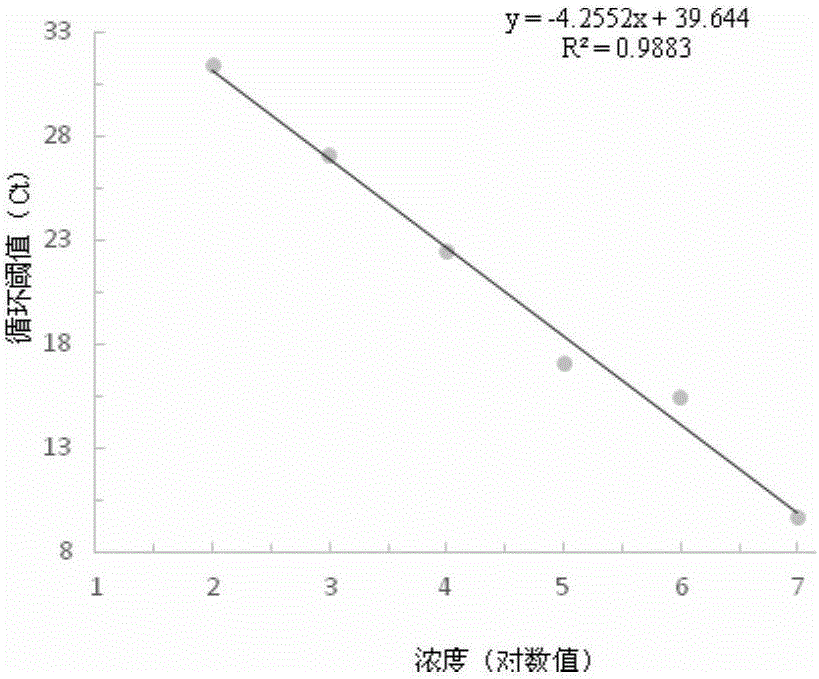Aeromonas salmonicida SYBR Green I real-time quantitive PCR (Polymerase Chain Reaction) detection method and application thereof
A technique for auxiliary detection of Aeromonas salmonicida, applied in the biological field, can solve the problems that PCR technology is difficult to achieve high specificity, stable repeatability, and difficult to popularize
- Summary
- Abstract
- Description
- Claims
- Application Information
AI Technical Summary
Problems solved by technology
Method used
Image
Examples
Embodiment 1
[0039] Example 1. Design of primers for detection of Aeromonas salmonicida and its detection method
[0040] 1. Design of primers for detection of Aeromonas salmonicida
[0041] According to the sequence of Aeromonas salmonicida fstA gene (accession number: AM712656.1) on GenBank, a pair of specific primers were designed using the primer design software PrimerExplorer and synthesized by Suzhou Jinweizhi Biotechnology Co., Ltd. The primer sequence:
[0042] AsF-F: 5'-TTGTCGGCGAACCTTGTAG-3' (SEQ ID NO: 1);
[0043] AsF-R: 5'-CAAGAGCAAGACGCAGACG-3' (SEQ ID NO: 2).
[0044] 2. Method for detecting Aeromonas salmonicida
[0045] Using the genomic DNA of the fish tissue sample to be tested as a template, the AsF-F / AsF-R primers in step 1 are used to perform fluorescent quantitative PCR to obtain PCR amplification products.
[0046] If the PCR amplification product meets the following conditions: an amplification curve is generated, and the Ct value is 0-38, it means that the samp...
Embodiment 2
[0047] Example 2. Specific detection of primers for detection of Aeromonas salmonicida
[0048] 1. Genomic DNA extraction
[0049] Bacterial Genomic DNA Extraction Kit (purchased from Tiangen Biochemical Technology Co., Ltd.) was used to extract the genomic DNA of the following strains: Aeromonas salmonicida subsp. Aeromonas japonica subspecies, Aeromonas salmonicida subsp. Shirkerii, Aeromonas hydrophila, Aeromonas caviae, Aeromonas sobria, Aeromonas victoria, Ruckeri Yersinia, Edwardsiella tarda, Pseudomonas fluorescens, Staphylococcus aureus, and Micrococcus myelyticus. The number, Latin name and source of each strain are shown in Table 1.
[0050] Table 1 Strains and their sources
[0051]
[0052] 2. Conventional PCR amplification and fluorescent quantitative PCR amplification
[0053] Using the genomic DNA of each strain obtained in step 1 as a template, the primers designed in step 1 were used for conventional PCR amplification and fluorescent quantitative PCR am...
Embodiment 3
[0060] Example 3. Sensitivity detection of primers for detection of Aeromonas salmonicida
[0061] 1. Preparation of plasmid standards
[0062] Measure the concentration and the purity of the solution containing the pMD18T-fstA recombinant plasmid obtained in (1) in 2 of step 2 of Example 2 with a micro-ultraviolet-visible spectrophotometer, and calculate the concentration and purity of the pMD18T-fstA recombinant plasmid per unit volume according to Moore's law. DNA copy number, and the recombinant plasmid as a standard, the calculation formula is as follows:
[0063]
[0064] Among them, the plasmid concentration is 105ng / μL; the plasmid volume is 1μL; the vector length: 2692bp; the fragment length is 170bp. Final calculation result: the DNA copy number contained in each μL recombinant plasmid is 3.3×10 10 .
[0065] Second, the sensitivity of fluorescent quantitative PCR
[0066] The solution containing the pMD18T-fstA recombinant plasmid was subjected to 10-fold ser...
PUM
| Property | Measurement | Unit |
|---|---|---|
| volume | aaaaa | aaaaa |
Abstract
Description
Claims
Application Information
 Login to View More
Login to View More - R&D
- Intellectual Property
- Life Sciences
- Materials
- Tech Scout
- Unparalleled Data Quality
- Higher Quality Content
- 60% Fewer Hallucinations
Browse by: Latest US Patents, China's latest patents, Technical Efficacy Thesaurus, Application Domain, Technology Topic, Popular Technical Reports.
© 2025 PatSnap. All rights reserved.Legal|Privacy policy|Modern Slavery Act Transparency Statement|Sitemap|About US| Contact US: help@patsnap.com



